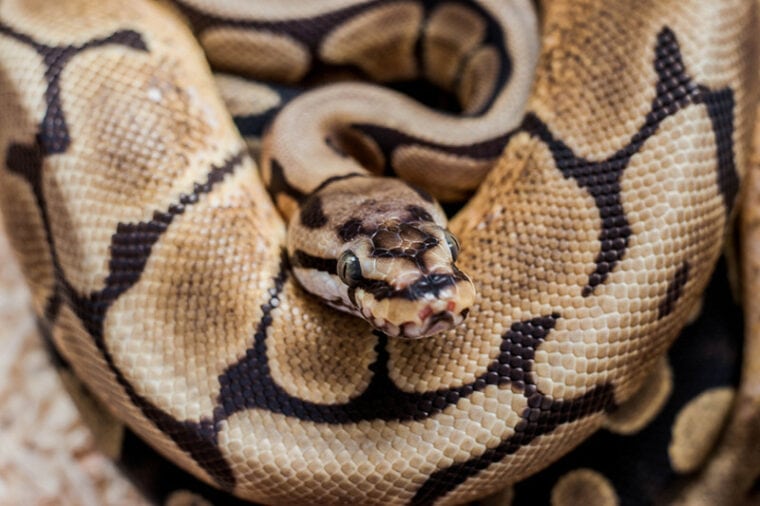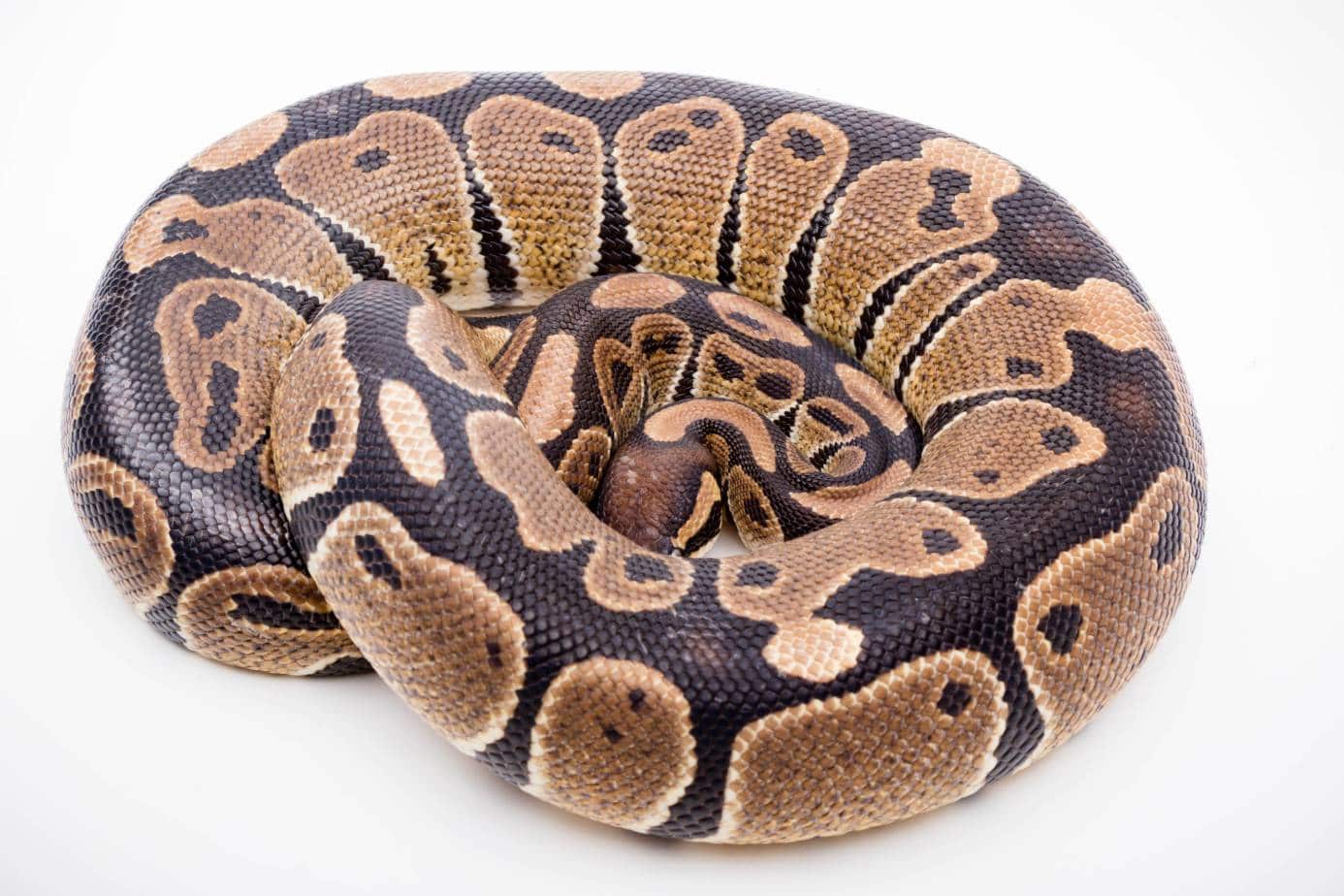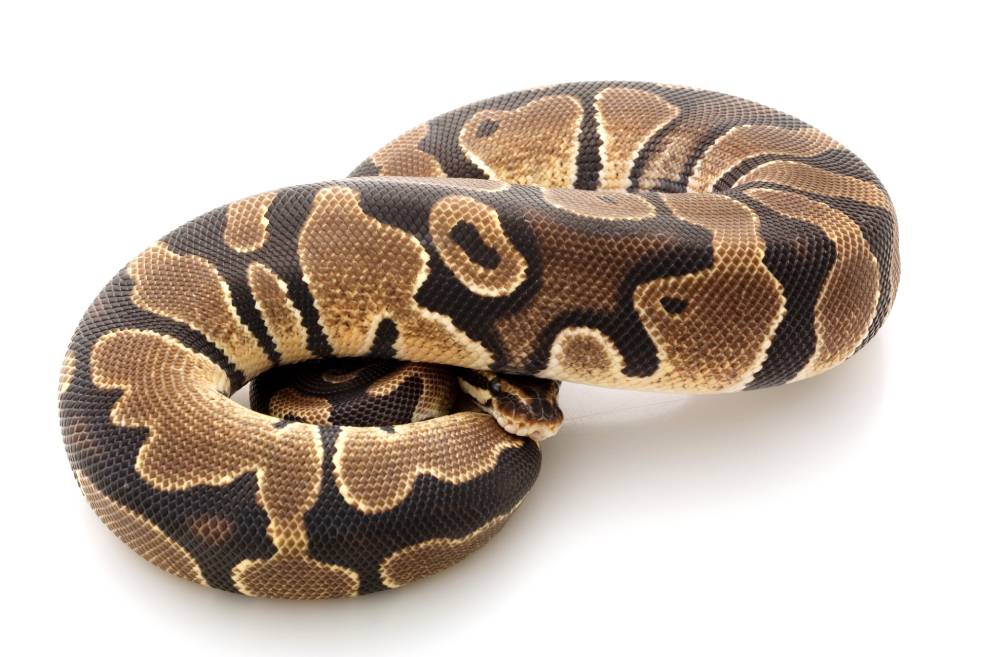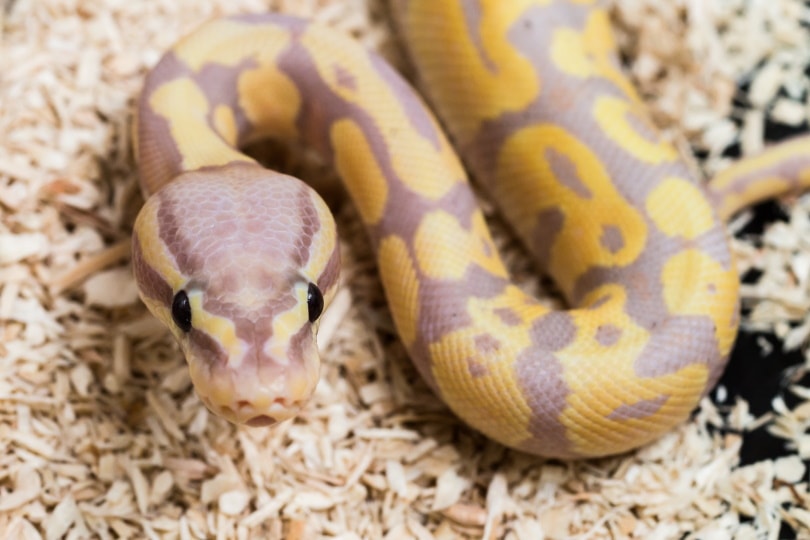
Click to Skip Ahead
The world of ball pythons is full of many different morphs with various colors and patterns. One of the most commonly known morphs in the reptile hobby is the spider ball python. These unique-looking snakes have been part of the hobby since the late 1990s and they’ve been used to create many other morphs. In this article, we’re going to go more in-depth about the spider ball python in every way imaginable, so keep reading to learn more.
| Care Level: | Suitable for all experience levels |
| Lifespan: | 20 – 40 years |
| Adult Size: | 3 – 6 feet |
| Diet: | Carnivore (small rodents) |
| Minimum Tank Size: | 15 – 20 gallon (baby/juvenile); 40 gallon (adult) |
| Temperature & Humidity: | Temperature: 82°F (ambient) Humidity: 55 – 70% |
The ball python originates from Western and Central Africa and gets their name from their defensive posture of curling into a ball to protect their heads. How the first ball pythons entered the pet trade is not well documented, but their popularity picked up around the 1980s.
Thanks to their beauty, docile temperament, manageable size, low-maintenance care requirements, and color morph varieties, they quickly became one of the most popular pet snakes and to this day remain a favorite among reptile keepers of all experience levels.
The first spider ball python on record was imported from Africa by an employee of a Los Angeles pet store. The snake lived with the individual for two years before being sold to breeder Lindy Johnson of Freedom Breeder.
Ultimately, the same snake was sold to Kevin McCurley of New England Reptile Distributors who successfully bred this snake with a unique genetic mutation and introduced the spider morph to the reptile hobby in 1999. Spider ball pythons are now among the most common morphs found in the pet trade and have been used to create a variety of others.
Do Spider Ball Pythons Make Good Pets?
Spider ball pythons have the potential to make excellent pet snakes when in the hands of a responsible keeper. The proper care and husbandry of any pet snake are vital to its overall health and longevity, and anyone interested in having one as a pet should do their research and be well-prepared before bringing a snake home.
Ball pythons are very well known for being docile and easy to handle. They reach a manageable size of 3 to 6 feet when fully grown with a thicker-than-average girth when compared to other common pet snakes. The upfront costs can be expensive, but they are very easy to maintain and are often a hardy species when kept under proper environmental conditions.

Are Spider Ball Pythons Friendly? Our Handling Advice
Ball pythons are a shy, reclusive species that are known for having docile temperaments. These snakes spend most of their time secured within the comfort of their hides. Snakes do not form emotional bonds with their keepers but build a tolerance for being handled.
Baby ball pythons are often more wary of being handled, which is a natural survival response. It can take time and regular handling to get them comfortable but overall ball pythons are very popular because of their handleability.
Keepers should aim to handle regularly, about once per week for no more than 10 minutes at a time. Excessive handling can be very stressful for the snake, so you want to avoid making it a completely unpleasant experience for them.
We do not recommend handling a brand-new ball python for at least 2 weeks as they settle into their new environment. A habitat change is stressful on its own, so you don’t want to add to that stress but rather give them time to adjust. You should also avoid handling for at least 2 to 3 days after feeding to prevent regurgitation and ensure their meal is properly digested.
How Much Do Spider Ball Pythons Cost?
Spider ball pythons are among the least expensive morphs in the hobby. This is largely because they’ve been around for quite some time. Price does vary depending on the snake’s age, size, and sex, but spider morphs typically range between $50 and $300.
Appearance
Various morphs include the spider gene, the original spider morph’s coloration is very similar to that of a normal ball python. They display a unique, thin dark puzzle pattern with larger brown to golden blotches. This patterning is primarily unbroken and runs along the body from one side to the other.
While their overall coloration may be similar, they are unlike the normal ball python with thick dark markings and smaller blotches. Spiders also have a significant contrast of colors, ranging from white to yellow, that splatters along the edges of the body. They typically have lighter-colored eyes as opposed to the normal ball python’s dark eyes.
Another prominent feature of the spider morph is bold markings with a darker spot on the head that is sometimes referred to in the hobby as an “alien head.” This marking makes them easily distinguishable from non-spiders within a new clutch.

How to Take Care of a Spider Ball Python
Feeding & Diet
Ball pythons will eat a diet of whole prey rodents. We recommend only feeding captive-bred, appropriately sized rats, or mice. Do not ever take a rodent from the wild and offer it as a meal to your pet snake, as it can lead to serious health complications and even death.
Ball pythons can be finicky eaters, which is the biggest downside to the species, especially in the hands of beginner keepers. They often imprint on a particular food source, which can be problematic when switching from smaller mice to rats. Rats will ultimately be the primary food source for adult ball pythons, so it is recommended to offer rats as soon as possible to make the transition easy.
Prey Size
They should be fed appropriately sized prey that is no wider than the widest part of the body. This helps prevent any issues with digestion and the regurgitation of oversized prey. Baby ball pythons may need to start with pinky mice and the prey will need to increase in size as they grow.
Frozen-Thawed Is Best
Frozen-thawed rodents are highly recommended, not just for ethical reasons but also for the safety of the snake. Live prey can harm the snake when cornered in an enclosure with no escape. Your snake could be bitten, scratched, and injured if the prey tries to defend itself. This opens up the risk of infection and veterinary bills that are easily avoided with proper feeding practices.
Keepers may have trouble with their ball python accepting frozen-thawed prey at first. If this is the case, we recommend spacing out the feeding by an additional week to help entice them to eat. If you must offer live prey, they should never be left unattended with a snake and need to be removed immediately if your snake shows no interest in eating.
Feeding Schedule Suggestions
Baby and juvenile snakes are typically fed once every week to 2 weeks, and adults can be fed once every 2 to 4 weeks. For the best feeding recommendations and advice, we recommend contacting your veterinarian.
Trouble Feeding
Some spider morphs may have trouble feeding due to the genetic neurological disorder known as the “wobble”. If that is the case, frozen-thawed is a must and you may need to assist with feeding under the guidance of your veterinarian.
Habitat, Tank Conditions & Setup
Tank
To prevent unneeded stress and ensure your snake feels secure, we recommend housing your spider ball python in an enclosure that suits its current size. For babies, we suggest smaller terrariums between 15 and 20 gallons. As the snake grows, the enclosure size can be increased, with adults typically requiring an enclosure between 40 and 50 gallons.
Ball pythons are not climbers, so they do not need a tall enclosure. There are plenty of enclosure options out there with the most popular being PVC, secure plastic tubs, and glass terrariums. Each has its pros and cons, you just want to ensure it holds the appropriate conditions well and securely locks, as these snakes are no strangers to escape attempts.
You should always provide two hides within the habitat that are appropriate to the snake’s size. One hide should be located on the cool side, and the other on the warm side. You should also provide a water dish large enough for soaking that is always full of clean, fresh water.
Lighting
Ball pythons do not require any special lighting like other species of reptiles. These animals are crepuscular, meaning they are most active at dawn and dusk, so it’s important to have the lighting within the room follow a typical night and day schedule. A 12-hour on, 12-hour off light cycle helps mimic their natural rhythms.
Heating
As cold-blooded animals, spider ball pythons cannot regulate their own body temperature and require external sources of heat. Maintaining the correct temperature and humidity levels in their environment that best mimics the conditions of their native land is important for their overall health and well-being.
Temperature
There should be a dedicated warm side and a dedicated cool side, each with its own hide within your ball python’s enclosure. The warm side should be kept between 85–91°F and should never exceed 93°F, while the cool side should be kept around 80°F and never below 75°F.
The average ambient, or overall, temperature of the enclosure should be kept around 82°F. You can use a heat mat, heat tape, or radiant heat panels to help maintain proper temperature. This can easily be monitored by a thermostat, which we recommend reads both sides of the enclosure.
Humidity
On average, ball pythons need a humidity range between 55–70% with babies sometimes needing slightly higher levels. To maintain proper humidity, you need an appropriate substrate and can mist the enclosure with fresh, clean water.
The water dish will also help with humidity and can be placed on the hot side of the enclosure. This will cause the water to evaporate more quickly and release humidity, just make sure to monitor the water levels closely and replenish as needed.
Proper humidity is essential for proper shedding and overall health, so you should monitor the humidity with a hygrometer.
Substrate
There are several types of substrates you can use for a spider ball python’s habitat. Some keepers choose to use newspapers or paper towels, but for a more naturalistic environment, you can opt for coconut fiber, aspen chips, cypress mulch, or repti bark. Each has its own advantages and disadvantages, so do your research to see which you would prefer.
Never use sand or cedar substrate. Sand can easily be ingested during feeding and lead to a potentially life-threatening impaction of the gastrointestinal system. Cedar is highly toxic to snakes and other reptiles due to the oils and fumes within the wood.
 Keeping Your Spider Ball Python Healthy
Keeping Your Spider Ball Python Healthy
Proper care and husbandry are key to keeping your spider ball python healthy. While typically a hardy species, there are some health concerns that every keeper should be aware of and know what to look for. You should establish care with a veterinarian with reptile experience in case your ball python needs medical attention.
The 5 Common Health Issues
1. The “Wobble”
The genetic mutation associated with the spider ball python’s unique look is directly associated with a neurological disorder known as the “wobble.” This genetic disorder causes the head to twist and sway and is present across all spider morphs to some degree.
The severity of this condition of the central nervous system varies depending on each individual. In some cases, it may be difficult to recognize while in others it may be so severe that it affects the snake’s locomotion and ability to feed. There is no cure for the condition, but in most cases, it is manageable, though there are some cases that result in a failure to thrive.
2. Mites
Mites are a parasite that affects snakes. They will commonly hide in the grooves between the scales on the underside of the jaws. Mites reproduce quickly and can cause your ball python a significant amount of discomfort, and eventually lead to anemia and death, so they must be dealt with quickly and thoroughly.
The first indicator of mites is frequent soaking in the water dish. You can identify them by observing your snake up close, as they look like tiny, dark specks. You should contact your veterinarian for assistance with a mite infection and you will need to treat your snake and its enclosure to prevent reinfestation.
3. Respiratory Infection
Respiratory infections are a common ailment among pet snakes. It is typically the result of poor husbandry and often occurs when their environmental temperature is either too cold or the humidity is too high.
A telltale sign of a respiratory infection is a distinct wheeze. More severe signs of respiratory infection include holding the head up, open mouth breathing, gurgling noises while breathing, and a mucous discharge from the nostrils. Respiratory infections are very serious, and you must seek treatment from your vet right away.
4. Dysecdysis (Shedding Issues)
Dysecdysis refers to trouble shedding and occurs frequently in captive snakes. All snakes shed as they grow and will continue to shed throughout their entire lives. Snakes shed their entire body including their eye caps (called spectacles).
Trouble shedding is often caused by poor humidity or a lack of objects in the enclosure to assist with the shed. Never try to remove a stuck shed on your own, as you can cause injury to the snake. It’s always recommended to reach out to your veterinarian for any questions or concerns over shedding.
5. Scale Rot
Scale rot is more of an all-encompassing term to refer to any issues related to the scales or skin. This includes conditions such as dermatitis, burns, bacterial abscesses, and even secondary bacterial infections that result from abrasions or burns. Scale rot is often the result of poor husbandry and can easily be prevented. You should seek prompt treatment if you notice anything unusual with the scales.
Shedding & Brumation
Shedding
Snakes continuously shed throughout their lifetime, though the frequency of shedding decreases once your snake reaches full maturity. Younger snakes will naturally shed more often since they are growing at a faster rate.
When a shed is approaching, the spider ball python’s scales will take on a duller appearance and their eyes will appear cloudy and blue. Their underside may also appear more pink than usual. Many ball pythons will refuse meals right before a shed, as they are more vulnerable during this time.
Proper humidity levels are key to a successful, healthy shed. Some keepers will raise the humidity levels slightly during this time to ensure a full shed. You can also help by placing decor within the habitat for your snake to rub against to help peel the skin away.

Brumation
Ball pythons will not brumate, though some adult ball pythons may eat much less or refuse to eat at all during the winter. Those that refuse to eat will often return to normal feeding habits in late winter or early spring. If there are any concerns over your ball python’s appetite or the frequency of feedings, contact your veterinarian.
Lifespan
The life expectancy for a captive ball python is between 20 and 40 years, with 30 years being the average. In rare cases, they have been recorded living up to 50 years. In the wild, threats such as predators and hunters make the lifespan of wild ball pythons much shorter, averaging only 10 to 15 years if they manage to survive to adulthood.
Breeding
Since ball pythons are kept alone, there’s no risk of accidental pairings, but keepers may choose to breed ball pythons as a hobby, to add to their collection, or even to start a small breeding business. Breeding ball pythons require knowledge of their unique genetics.
With spider ball pythons suffering from the incurable neurological disorder known as the wobble, there’s a lot of controversy about breeding this gene. We recommend that novice breeders do extensive research into these snakes and the health effects of their genetic mutation. No Spider morph that suffers from moderate to severe wobble should ever be bred.
You should first get approval from your veterinarian before breeding and ensure the snake is of ideal breeding age and size. You will also need to know proper breeding conditions, how to properly pair males and females, recognize ovulation, and successfully incubate and hatch the eggs.
3 Little-Known Facts About Spider Ball Pythons
1. There Is Controversy Over Breeding This Gene
There is a lot of controversy surrounding the continued breeding of spider ball pythons because of ethical concerns regarding the snake’s quality of life. The central nervous system disorder or “wobble” does not have a cure and affects every snake with this gene.
Some argue that there is no effect on quality of life, as many spider morphs have lived long, happy, healthy lives. On the other hand, there have been many petitions started to outlaw the breeding of any ball pythons with this gene stating that it’s cruel and unethical.
In 2018, the International Herpetological Society in Europe prohibited the sale of spider ball pythons at their shows. There are still no laws against the breeding of spider ball pythons in the United States or Europe and it remains a hot controversial topic within the reptile community.
2. The Spider’s Genetic Mutation is Categorized as Incomplete Dominant
Genetic mutations can be inherited differently, with mutations being categorized as either dominant or recessive. When a mutation is recessive, it means that the snake will need to receive a copy of the mutation from both parents to physically display the trait.
With a dominant mutation, only one copy of the mutated gene from a single parent is needed to produce the desired appearance. The Spider gene is considered a dominant mutation, which can be broken down into dominant, co-dominant, and incomplete dominant varieties.
This specific gene is considered incomplete dominant. When breeding a spider morph with a normal ball python, some of the clutches will be spiders as well.
3. Spiders Have Been Used to Create Many Popular Morphs
Unique genetic mutations as seen in the spider ball python will quickly gain popularity. The spider morph became a favorite among breeders and snake hobbyists, resulting in the creation of many other morphs through selective breeding.
There are many ball python morphs on the market that have the spider gene, and they can range in price from $100 to $25,000 or more for a single snake, depending on the color, pattern, age, size, gender, and rarity of the morph. Some of the most well-known morphs created using spider ball pythons include:
Final Thoughts
The spider ball python was first introduced into the reptile hobby in 1999 when Kevin McCurley of New England Reptile Distributors successfully bred the first spider morph that had originally been imported from Africa. The genetic mutation that causes the unique appearance of the Spider is also associated with a neurological condition known as a “wobble” that affects all snakes with the gene to some degree.
While there is some controversy over breeding spider ball pythons, they remain one of the most common and least expensive morphs in the hobby. With proper care and husbandry, a spider ball python morph can make an excellent pet snake for keepers of all experience levels.
Featured Image Credit: Banyo, Shutterstock







